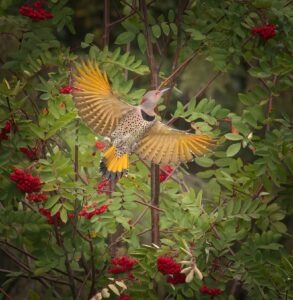A Birdwatchers Guide to Heartland Lakes
If you’re among the one in five Americans who identify as a birdwatcher or want to join the ranks, you will be delighted to see birds you may not expect to find in our parks and forests and along the lakes, rivers and trails in the Heartland Lakes area.
Spring
The spring migration parade can begin as early as mid-March in our part of the state. Itasca State Park is open year round and considered a premier birding area. Over 20 species of warblers nest or migrate through the park and are among 222 species sighted there. Bird feeders maintained at the Jacob V. Brower Visitor Center give visitors a peek at what the park has in store when you can walk the trails or cruise the shoreline of Lake Itasca or one of the park’s other lakes. Check out the park’s bird checklist.
The 43,000-acre Tamarac National Wildlife Refuge Visitor Center opens mid-May. The refuge’s reason for being is to be a refuge and breeding ground for migratory birds or other wildlife. As at Itasca State Park, you can enjoy seeing birds at the feeders or simply step onto the observation deck to see trumpeter swans, loons and other wildlife. As time permits, there are many ways to explore the refuge and schedule a time of year to see some of the species listed here.
You can sign up for an annual organized birding event, The Detroit Lakes Festival of Birds in May. It offers field trips, guest speakers and fun activities like bird trivia.
Summer
By June, the trees are alive with bird song and wildflowers that attract some of our featured friends bloom in the countryside along fields and ditches, our beautiful biking and hiking trails and lakes where humans haven’t intervened.
Among those places are the state forests in the Heartland Lakes area. The Paul Bunyan, Smoky Hills, Two Inlets and Huntersville State Forests are the largest. Download maps or find paper copies at the Chamber Visitor Center. Another way to find a variety of bird species is to hike the Heartland State Trail or North Country National Scenic Hiking Trail.
Naturalists lead programs at Itasca State Park and the Tamarac National Wildlife Refuge for adults and kids of all ages. Some programs are specific to birding and introduce visitors to places to look for birds.
Fall
Fall means seeing migratory birds in reverse from those that passed through in the spring along with scenic views as the landscape transitions from green to fall’s brilliant colors. The last young loons are leaving and Canada geese and ducks also depart. When you hear them, you can’t help but look up in awe. Unless there’s an early snowfall, roads and trails that might not be open in the spring should be open to access more remote spots.
Winter
In early winter trumpeter swans gather in fields to pick through what’s been left behind after the harvest. Some find open water and stay all winter. Potato and Fish Hook Lake are two spots to find them. In the silence of winter it can be easier to hear various species, such as owls, and find them. Every four or five years there’s an irruption of northern owls. One winter several snowy owls were seen on state Highway 64 between State Highways 34 and 200.
Every year in December, Itasca State Park hosts a winter bird count, that is part of the larger nation-wide Audubon Christmas Bird Count. Participants can stay a few hours or spend the whole day. Information collected is used to track migration patterns and changes in winter bird species abundance throughout North America. To learn more about this nation-wide bird survey go here.
New to Birding?
This article from Explore Minnesota is a great place to start. In terms of gear, all you may really need is a good pair of walking shoes, but a pair of binoculars and a field guide (identification app or guidebook) will improve the experience. Most cell phones can zoom in to capture a good image or you can go big and add a powerful lens to a camera for a shot good enough to print.

